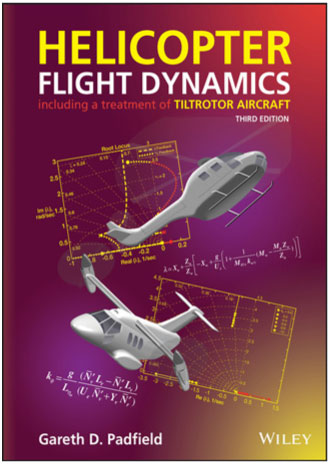
This is the Third edition of the book from a world-renowned expert in the field of rotorcraft flight dynamics. The book is aimed at practicing engineers in the field as well as students at both the undergraduate and postgraduate level. It includes both descriptive material and the necessary mathematics required to develop detailed simulation models. Several chapters have been enhanced from previous editions, and it includes two new chapters.
The book is organised into three main primary sections with useful introductory material for those new to the field of rotorcraft flight dynamics. These sections are:
1. Modelling
2. Flying qualities (including flight in degraded environments)
3. Tiltrotors
As the author clearly states, the book concentrates on modelling and the development of flying qualities criteria rather than how to design to achieve specific flying qualities, which does not detract from the book in any way.
After the introductory material, the book delves deeply into the mathematics necessary to create models for the analysis of flying qualities as should be expected for a book that is primarily aimed at engineers working in this field of study.
In an appendix at the of end of Chapter 5 ‘Modelling Helicopter Flight Dynamics: Stability Under Constraint and Response Analysis’, there is an interesting and informative analysis of both fixed-wing and rotary-wing aircraft accidents related to flight path speed instability.
A new chapter (Chapter 9 ‘Flying Qualities: The Story of an Idea’) provides a detailed account of the history of flying qualities and how assessment criteria and standards have been developed over time up to the modern era and ADS-33. This chapter also makes comparisons and observations regarding how the discipline is treated differently in the military and civil worlds. Personally, I would have found this useful towards the start of the book, after some of the introductory material, as it gives the reader insight and understanding of the basis of the ADS-33 material that follows.
The other new chapter, Chapter 10 ‘Tiltrotor Aircraft: Modelling and Flying Qualities’ is very comprehensive both in terms of the explanations of tiltrotor dynamics and the related mathematical modelling.
Some readers may find the mathematical sections quite daunting, but there is still much to be gained from the book for all who are interested in the field. In general, the book is well-organised and provides a wealth of detail for the specialist. The references are comprehensive and will be a valuable resource for further research and study.
For the addition of the chapter on tiltrotors alone, the book will be a worthwhile addition to both personal and technical libraries, but all the new material makes for a valuable new edition.


